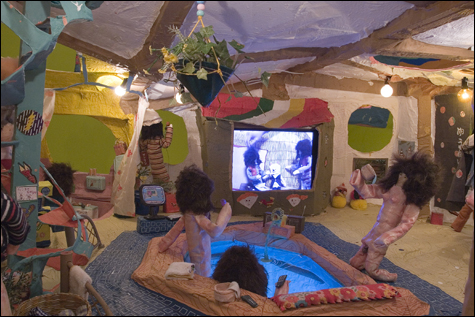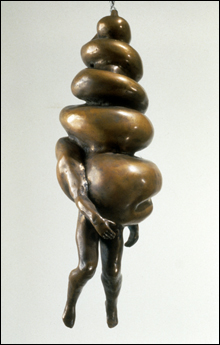
SPACE HOUSE: Fucked-up technique plus verve equals great art if you get it “wrong” in just the right ways. |
Misaki Kawai’s Space House is what Barbie’s Dream House would look like if Barbie weren’t such a stuck-up square plastic bimbo. Fresh from a museum show in Tokyo, Kawai’s room-filling, papier-mâché installation at the Institute of Contemporary Art is a miniature doll-house space station Shangri-La from a rainbow-bright future. And it’s wicked cool.
The station is built of pods dangling from the ceiling on clear plastic wires and illuminated inside by tiny lights. All the pods are linked by a screwball monorail system; think hamster cages linked by tubes. Cloth and wire dolls with photographic faces (Kawai, her family, friends, the Beatles), shaggy hair, and stumpy limbs populate this universe. “Dr. Robot” peeks into the chest of a robot lying on an examination table. A man pins his pants and his underwear to a clothesline running between walls decorated with pictures of John Lennon, Harry Potter, and a collie. Downstairs, pipe-cleaner kitties romp in a scratching-post paradise. Dolls scoot about on sticker-covered rocket cycles trailing contrails of cotton batting. People and furry critters ride carts along wooden monorail tracks with their hands up in the air, as if they were screaming down roller-coaster hills.

A doll Kawai paints in a splattered studio lined with mini versions of her paintings while downstairs two guys exercise as a real video of a puppet exercise show plays on a mini TV. On the other side of the gallery, another doll Kawai boozes it up with friends as a cat-head person sings karaoke into a microphone connected to a little TV that plays a tiny music video with a soundtrack of bleeping kids’-toy sounds.
George Harrison, John Lennon, and a bear person lounge and drink and play guitar under green cone trees on a patio while friendly birds and squirrels scurry about like extras from a Disney flick. Two naked ladies and a naked dude (Lennon again) chill in a big blue Jacuzzi and watch a “giant” screen television playing Kawai’s puppet video soap opera, kids’ show, robot-narrated weather report, and newscast.
There’s so much detail, you fear you’ll miss something — the guy (Kawai’s boyfriend, the artist Taylor McKimens) on the telephone, her grandmother leaning on a windowsill gazing out into space, a guy taking a dump in the women’s room with a tiny pin-up in the stall, Fujiyama painted on the Jacuzzi-room wall, dozens of itty-bitty magazines.
The 29-year-old Japanese-born, Brooklyn-based artist works in an irresistible style called Cute Brut — cute, cartoony pop styles mixed with folkie or Art Brut techniques. You could also use the Japanese term “hetauma,” a marriage of the Japanese words for bad and good. The idea is like punk rock — fucked-up technique plus verve equals great art if you get it “wrong” in just the right ways.
As in much art these days, Kawai’s underlying subject is our ever more technological society, where our snazzy digital gewgaws — iPods, e-mail, camera phones, YouTube — mean we increasingly experience the world indirectly and our science and our machines allow us to manipulate everything from genes to voting to war to ecosystems. For many contemporary artists, adopting a crafty DIY style expresses a craving for direct experience even as it interrogates our techno culture. Kawai tells me she adores all this technology (Space House is the bright future of old sci-fi cartoons and movies), but her handmade style is her way of saying, “I don’t want people to lose their human heart.”
The result is an imagined world in which all people do is drink, paint, sing, exercise, repair robots, cruise. The message: let’s have fun again. “To me it feels like a lot of art . . . is too serious,” Kawai says. “I think it’s good, like politics, whatever they want to say, but also it doesn’t have to be that serious. It can be a fun thing to look at.” For me, Space House is an amusement-park kind of fun — not much to chew on during the trip home, but a thrilling ride while it lasts.

SPIRAL WOMAN (1951): Bourgeois’s spiral or bulbous shapes conjure a personal iconography. |
The ICA’s “Bourgeois in Boston,” meanwhile, presents a satisfying, career-spanning selection of 20 works by Louise Bourgeois borrowed from Boston-area collections — nearly half from Barbara Lee of Cambridge, an ICA trustee and a major contributor to the institution.Bourgeois, a 95-year-old French-born Surrealist who has lived in New York since 1938, is best known as a sculptor, but the exhibit includes a rare early painting, 1932 (1947), in what could be a mash-up of Giorgio de Chirico’s mysterious representational scenes and Roberto Matta’s abstraction. Named for the year Bourgeois’s mother died, the canvas features an odd cart — circus cart? vendor cart? funeral wagon? — spot-lit in the center. Red stripes stream across the background. A blurry feathery thing at the left suggests a big jagged abstracted bird fluttering inside a cage.